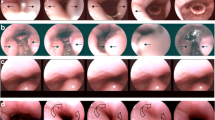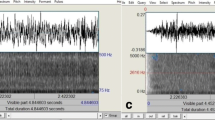Abstract
Stroboscopy is routinely used in voice disorder clinics but its use in studying the mechanisms of upper airway obstruction in patients who snore has not yet been described. This study combines the use of stroboscopy during sleep nasendoscopy to evaluate the oscillations and vibrations observed during snoring in slow motion. In addition, we utilised the multi-dimensional voice programme simultaneously to study some of the acoustic parameters of snoring whilst visualising the dynamics of the upper airway. Forty-five patients with primary snoring or mild obstructive sleep apnoea were recruited at two different centres and underwent sleep nasendoscopy. The simultaneous use of acoustic analysis was included to ascertain whether sound analysis alone could replace the need for using the sedation endoscopy in these patients. The use of a stroboscopic light source indeed enhanced the visualisation during the procedure and some subtle aspects of the mechanisms of upper airway obstruction, such as vibrations of the posterior pharyngeal wall and mucosal waves were identified. Most of the patients in this study exhibited multilevel obstruction and thus acoustic analysis alone would not be sufficient in accurately locating the site of upper airway obstruction in snorers.







Similar content being viewed by others
References
Hewitt RJ, Dasgupta A, Singh A, Dutta C, Kotecha BT (2009) Is sleep nasendoscopy a valuable adjunct to clinical examination in the evaluation of upper airway obstruction? Eur Arch Otorhinolaryngol 266:691–697
Kotecha BT, Hannan A, Khalil H, Georgalas C, Bailey P (2007) Sleep nasendoscopy: a 10-year retrospective audit study. Eur Arch Otorhinolaryngol 264:1361–1367
Mehta DD, Deliyski DD, Hillman RE (2010) Commentary on why laryngeal stroboscopy really works: clarifying misconceptions surrounding Talbot’s law and the persistence of vision. J Speech Lang Hear Res 53:1263–1267
Saunders NC, Tassone P, Wood G, Norris A, Harries M, Kotecha B (2004) Is acoustic analysis of snoring an alternative to sleep nasendoscopy? Clin Otolaryngol Allied Sci 29:242–246
Xu H, Huang W, Yu L, Chen L (2010) Sound spectral analysis of snoring sound and site of obstruction in obstructive sleep apnea syndrome of. Acta Otolaryngol 130:1175–1179
Miyzaki S, Itasaka Y, Ishikawa K, Togawa K (1998) Acoustic analysis of snoring and the site of airway obstruction in sleep related respiratory disorders. Acta Otolaryngol Suppl 537:47–51
Agrawal S, Stone P, McGuiness K, Morris J, Camilleri AE (2002) Sound frequency analysis and the site of snoring in natural and induced sleep. Clin Otolaryngol 27:162–166
Hara H, Murakami N, Miyauchi Y, Yamashita H (2006) Acoustic analysis of snoring sounds by a Multidimensional Voice Program. Laryngoscope 116:379–381
Georgalas C, Garas G, Hadjihannas E, Oostra A (2010) Assessment of obstruction level and selection of patients for obstructive sleep apnoea surgery: an evidence-based approach. J Laryngol Otol 124:1–9
Kezirian E, White D, Malhotra A, Ma W, McCulloch C, Goldberg A (2010) Interrater reliability of drug-induced sleep endoscopy. Arch Otolaryngol Head Neck Surg 136(4):393–397
Ravesloot M, De Vries N (2011) One hundred consecutive patients undergoing drug-induced sleep endoscopy: results and evaluation. Laryngoscope 121:2710–2716
Pevernagie D, Aarts R, De Meyer M (2010) The acoustics of snoring. Sleep Med Rev 14:131–144
Won T-B, Kim SY, Lee WH, Han DH, Kim D-Y, Kim J-W, Rhee C-S, Lee CH (2012) Acoustic characteristics of snoring according to obstruction site determined by sleep videfluoroscopy. Acta Otolaryngol 132:S13–S20
Babar-Craig H, Rajani NK, Bailey P, Kotecha BT (2012) Validation of sleep nasendoscopy for assessment of snoring with bispectral index monitoring. Eur Arch Otorhinolaryngol 269:1277–1279
Acknowledgments
We wish to acknowledge that the Spire Hartswood Hospital purchased the stroboscopic equipment for this research study.
Author information
Authors and Affiliations
Corresponding author
Rights and permissions
About this article
Cite this article
Kotecha, B., Kumar, G., Sands, R. et al. Evaluation of upper airway obstruction in snoring patients using digital video stroboscopy. Eur Arch Otorhinolaryngol 270, 2141–2147 (2013). https://doi.org/10.1007/s00405-013-2370-y
Received:
Accepted:
Published:
Issue Date:
DOI: https://doi.org/10.1007/s00405-013-2370-y




